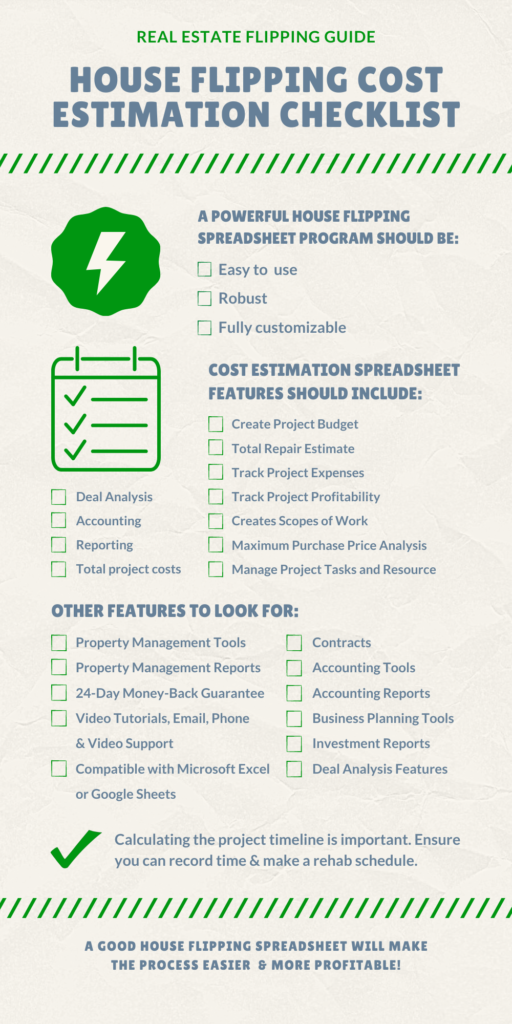How to use a home repair cost estimator is just one of the many skills to have when flipping houses.
This is because the most important considerations regarding successful house flip projects are the investment and carrying costs.
Flipping houses involves buying a house, fixing it up, and then reselling it for a profit. Professional investors know how to easily calculate home repair costs. However, you don’t need to be a professional to calculate the costs associated with home repair, you simply need the right tool.
What is a Home Repair Cost Estimator?
The home repair cost estimator is a calculator used to estimate repair costs on a property. This is typically a house flipping spreadsheet that is pre-built with national average unit costs and typical repair items.
The calculations are relatively simple – the quantity of work times the unit costs equals the total cost of work. This information is then fed into an analyzer to determine the maximum purchase price. A good cost estimator can be customized to your local market and specific needs. It should include tools such as project management, accounting, and reporting.
Learning How to Use a Home Repair Cost Estimator
It is essential to learn how to use a cost estimator properly. This is relatively easy for someone experienced with office software like Google Sheets or Excel.
These steps can be useful to follow:
- Notice any menus on the top, sides, and the bottom
- Use the left and right-click to check if they do anything
- Notice the menus, different color-coded sections, and other highlighted text.
Features to Use in a Home Repair Cost Estimator
These are just most of the things to look out for when using a home repair cost estimator:
After Repair Value (ARV)
Once you are aware of the amount people are willing to pay for your property, you can determine all other expenses, and figure out where to start to make some profit.
To accurately calculate the ARV, you should look at Comparables or “Comps”. These are recently sold or houses which are up for sale similar to your property, in the general area. This will give you a good indication of how much your house will sell for in the market.
Estimated Repair Costs (ERC)
A “standard” rehab usually includes all new flooring, paint (inside and outside), electrical and plumbing fixtures, new kitchen/bathrooms (including cabinets, granite, and appliances), baseboards, blinds and windows, doors, and perhaps some landscaping. You also need to account for the labor costs associated with making these repairs.
The ‘$20 per square foot’ Rule
This is a guideline that gives a pretty good idea of what it’s going to cost to fix up a house. A “standard” cosmetic rehab for most flip houses costs around $20 per square foot, so calculating the estimated total cost would simply depend on you knowing the square feet of the property.
Total Fixed Costs
These include the fees and costs associated with the investment project. You can calculate these by adding the purchase, holding, and sale costs together.
Purchase costs would include inspection costs, closing costs, and lender fees. Closing costs are attorney fees, courier fees, and state taxes.
Holding costs can include mortgage payments, property taxes, utilities (electricity, gas, and water), and insurance.
Selling costs would include commissions, home warranty, termite letter, and title insurance.
Rehab Profit
Calculating rehab profit with a home repair cost estimator is easy. You can click the % button or enter the approximate cost of the project to determine its profitability.
Additional/Hidden Costs
These include permit costs, contractor’s overhead, marketing costs, and realtor’s fees.
Total Repair Estimate
It’s important to get at least 3 estimates about the total repair costs from different contractors.
Calculated Maximum Purchase Price
This is the price you would offer to for a potential investment property.
This is normally the sum of the following: ARV + fixed costs + repair costs + repair contingency + profit.
Capital Needed
It’s important to calculate the capital you’ll need to make this purchase. If you’re borrowing then you need to know the annualized return on the capital borrowed.
Funding Available
Funding is a huge part of the process as it determines how many repairs you can afford to do. Maximizing funding for real estate projects is also about the ability to present to prospective lenders that you have the funds available. You can get these funds from a number of places – conventional loans, all cash, home equity line of credit (HELOC), or a hard money loan.
The most cost-effective financing option is the HELOC which is basically a mortgage on either your primary residence or another investment property. The last option is the toughest as it’s a lien on the property you’re buying and you should be prepared to lose the collateral if unforeseen circumstances arise.
70% Rule
The 70% rule is a way to determine what price should be paid for a fix and flip to make money. This rule states that an investor should pay 70% of the ARV of a property excluding the repairs needed.
Total Project Costs
The total project cost is basically a sum of all the various costs mentioned above. This is the total cost of fixing and flipping the house and it’s good to estimate this before actually deciding on whether to make the investment or not.
Total Capital Needed
The total capital costs for the entire house flip after it has been renovated are crucial. Compare these to the after repair sale value (ARV) on the open market. If the projected sale value is less than the overall cost of the purchase and renovation of the house, this is the wrong house to buy.
Return on Investment (ROI)
This determines whether or not the investment was worth making. The higher your ROI, the higher your profit. Before deciding to flip a house you should calculate the ROI. This can be calculated by dividing the amount of return by the total dollar amount for the investment.
For example:
I buy a house for $80,000, spend $20,000 on repairs and then rent if for 6 months. My total out of pocket is $100,000. The rent is $1,200 per month, or $7200 for the half-year period. My ROI for the year can be calculated by dividing $7200 (the return) by $100,000 (the investment), which is 0.072%. This is not a high return at all and making such an investment would not be advisable.
 Other Features of a Home Repair Cost Estimator
Other Features of a Home Repair Cost Estimator
Other useful features for a home repair cost estimator are:
- Deal Analysis Features
- Easy-to-Use Interface
- Video Tutorials, Phone, E-mail & Video Support
- Compatible w/Microsoft Excel or Google Sheets
- Investment Reports
- Property Management Tools
- Property Management Reports
- Accounting Reports
- Business Planning Tools
- Contracts
Total Scope of Work Document
The inspection work and desired improvements come together in the total scope of work document. This is an important document that lists all of the items that are needed, the materials required, and the deadlines you should adhere to.
If only one contractor is involved in the entire project, they will probably provide the scope of work and the estimate. If some of the work will be done on your own, or you plan to manage several subcontractors yourself, you will want a master scope of work, along with contracts with each of your service providers.
In a Nutshell
Making an accurate house repair estimate is essential to successful house flipping. Choosing which house to flip is a difficult decision to make. Underestimating or overestimating the costs involved with home repair is common and can lead to wasted time and money. Accurately estimating repair costs will allow you to maximize profit in the long run.
In the end, if you factor in all the costs associated with the home repair and adhere strictly to the 70% rule when buying, you are likely to make a substantial amount of profit. Be prepared for your costs to fluctuate because some of the estimates your home repair cost estimator calculated may be lower than the actual cost incurred.
Learn More…
Want to learn more about the costs of house flipping? Read this article.
More on house flipping costs can be found here.
< Back to Cost Estimation for House Flipping | NEXT: What flipping rehab cost traps should I avoid?

